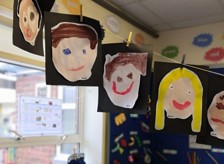 11th October 2024
11th October 2024Art
“Imagination is what allows your mind to discover.” Piet Mondrian.
At Hinchley Wood Primary School we highly value pupil’s art. Art creates an environment of belonging and can be a vital link to support children to discover their place in the world through self- expression. Creating art supports children’s ability to interact with the world around them by providing them with a new set of skills for self-expression and communication.
Our Art curriculum, gives our learners the opportunity to learn a progressive range of skills with increasing confidence across multiple disciplines and consider the role colour plays across them. Children develop their understanding of the visual language of art with effective teaching and considered sequences of lessons and experiences. Understanding of the visual elements of art and design (line, tone, texture, colour, pattern, shape, 3D form) helps to develop art skills and enables children to reach their full potential throughout their primary education.

Our main aim in art is to inspire our learners through exposing children to a range of artists, designers, crafts people and architects. Our Art curriculum has been carefully planned to ensure it includes artists from the past, present and has both local and global artwork to inspire.
In our Art curriculum, pupils discover their inner art critic by learning how to critically evaluate an artist’s work, which will in turn, inform their own work. Building upon their artistic appreciation allows them to develop their individual style in future lessons.
At Hinchley Wood Primary school, we see the value of giving children the opportunity experiment with ideas and techniques before applying them to a final piece. Through self-expression and using their imagination, the pupils explore and experiment with a variety of materials such as clay, textiles and paint. These experiments are documented in their sketch books, allowing the children to refer back to throughout their artistic journey. Making mistakes along the way is a key learning addressed throughout our experimental focused lessons. This allows pupils to build resilience while developing their problem solving skills simultaneously, all while developing their own unique flare. As the pupils develop their skills in using and handling different types of tools and techniques they apply these learnt skills to their own final piece. Showcasing their work with their peers, allows our pupils to critically evaluate their work by analysing what went well and how they would like to build upon their skills in the future. This is a key step in their journey for our artists.
“Art is never finished, only abandoned.” – Leonardo Da Vinci.
Finally, throughout our artistic journey, teachers ensure children are taught to build autonomy towards their art. The art of an individual is personal and unique to that child. It has worth in its own right, without having to be measured or judged by others as right or wrong. The ownership pupils have over their artwork, allows them to decide what their piece communicates, building confidence and self-esteem. Art is a fantastic way for pupils to express themselves and to learn to value their uniqueness in and outside the school gates and enhance their wellbeing.




















